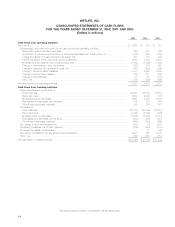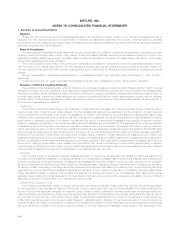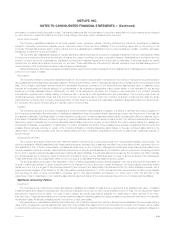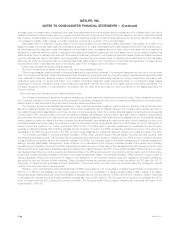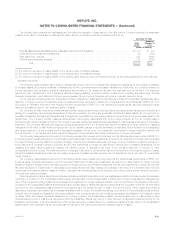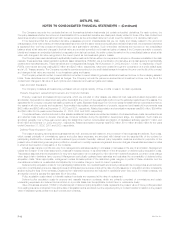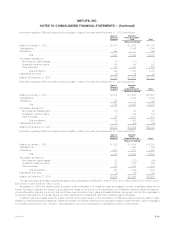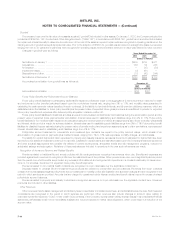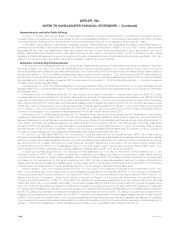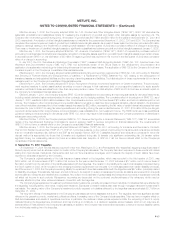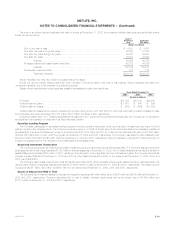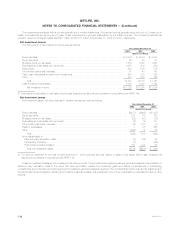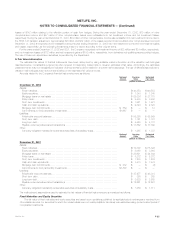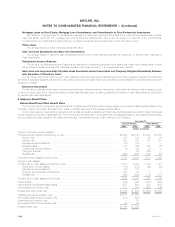MetLife 2002 Annual Report Download - page 60
Download and view the complete annual report
Please find page 60 of the 2002 MetLife annual report below. You can navigate through the pages in the report by either clicking on the pages listed below, or by using the keyword search tool below to find specific information within the annual report.METLIFE, INC.
NOTES TO CONSOLIDATED FINANCIAL STATEMENTS — (Continued)
Demutualization and Initial Public Offering
On April 7, 2000 (the ‘‘date of demutualization’’), Metropolitan Life Insurance Company (‘‘Metropolitan Life’’) converted from a mutual life insurance
company to a stock life insurance company and became a wholly-owned subsidiary of MetLife, Inc. The conversion was pursuant to an order by the New
York Superintendent of Insurance (the ‘‘Superintendent’’) approving Metropolitan Life’s plan of reorganization, as amended (the ‘‘plan’’).
On the date of demutualization, policyholders’ membership interests in Metropolitan Life were extinguished and eligible policyholders received, in
exchange for their interests, trust interests representing 494,466,664 shares of common stock of MetLife, Inc. to be held in a trust, cash payments
aggregating $2,550 million and adjustments to their policy values in the form of policy credits aggregating $408 million, as provided in the plan. In
addition, Metropolitan Life’s Canadian branch made cash payments of $327 million in the second quarter of 2000 to holders of certain policies
transferred to Clarica Life Insurance Company in connection with the sale of a substantial portion of Metropolitan Life’s Canadian operations in 1998, as a
result of a commitment made in connection with obtaining Canadian regulatory approval of that sale.
Application of Accounting Pronouncements
In January 2003, the FASB issued FIN 46 which requires certain variable interest entities to be consolidated by the primary beneficiary of the entity if
the equity investors in the entity do not have the characteristics of a controlling financial interest or do not have sufficient equity at risk for the entity to
finance its activities without additional subordinated financial support from other parties. FIN 46 is effective for all new variable interest entities created or
acquired after January 31, 2003. For variable interest entities created or acquired prior to February 1, 2003, the provisions of FIN 46 must be applied for
the first interim or annual period beginning after June 15, 2003. The Company is in the process of assessing the impact of FIN 46 on its consolidated
financial statements. Certain disclosure provisions of FIN 46 were required for December 31, 2002 financial statements. See ‘‘— Structured Investment
Transactions and Variable Interest Entities.’’
As of December 31, 2002, the FASB is deliberating on a proposed statement that would further amend SFAS 133. The proposed statement will
address certain SFAS 133 Implementation Issues. The proposed statement is not expected to have a significant impact on the Company’s consolidated
financial statements.
In December 2002, the FASB issued SFAS No. 148, Accounting for Stock-Based Compensation — Transition and Disclosure (‘‘SFAS 148’’), which
provides guidance on how to transition from the intrinsic value method of accounting for stock-based employee compensation under APB 25 to the fair
value method of accounting from SFAS 123, if a company so elects. Effective January 1, 2003, the Company adopted the fair value method of recording
stock options under SFAS 123. In accordance with alternatives available under the transitional guidance of SFAS 148, the Company has elected to apply
the fair value method of accounting for stock options prospectively to awards granted subsequent to January 1, 2003. As permitted, options granted
prior to January 1, 2003, will continue to be accounted for under APB 25, and the pro forma impact of accounting for these options at fair value will
continue to be disclosed in the consolidated financial statements until the last of those options vest in 2005.
In November 2002, the FASB issued Interpretation No. 45, Guarantor’s Accounting and Disclosure Requirements for Guarantees Including Indirect
Guarantees of Indebtedness of Others (‘‘FIN 45’’). FIN 45 requires entities to establish liabilities for certain types of guarantees, and expands financial
statement disclosures for others. Disclosure requirements under FIN 45 are effective for financial statements of annual periods ending after December 15,
2002 and are applicable to all guarantees issued by the guarantor subject to the provisions of FIN 45. The initial recognition and initial measurement
provisions of FIN 45 are applicable on a prospective basis to guarantees issued or modified after December 31, 2002. The Company does not expect
the initial adoption of FIN 45 to have a significant impact on the Company’s consolidated financial statements. The adoption of FIN 45 requires the
Company to include disclosures in its consolidated financial statements related to guarantees. See Note 11.
In June 2002, the FASB issued SFAS No. 146, Accounting for Costs Associated with Exit or Disposal Activities (‘‘SFAS 146’’), which must be
adopted for exit and disposal activities initiated after December 31, 2002. SFAS 146 will require that a liability for a cost associated with an exit or disposal
activity be recognized and measured initially at fair value only when the liability is incurred rather than at the date of an entity’s commitment to an exit plan
as required by EITF 94-3, Liability Recognition for Certain Employee Termination Benefits and Other Costs to Exit an Activity (including Certain Costs
Incurred in a Restructuring) (‘‘EITF 94-3’’). As discussed in Note 13, in the fourth quarter of 2001, the Company recorded a charge of $330 million, net of
income taxes of $169 million, associated with business realignment initiatives using the EITF 94-3 accounting guidance.
In April 2002, the FASB issued SFAS No. 145, Rescission of FASB Statements No. 4, 44, and 64, Amendment of FASB Statement No. 13, and
Technical Corrections (‘‘SFAS 145’’). In addition to amending or rescinding other existing authoritative pronouncements to make various technical
corrections, clarify meanings, or describe their applicability under changed conditions, SFAS 145 generally precludes companies from recording gains
and losses from the extinguishment of debt as an extraordinary item. SFAS 145 also requires sale-leaseback treatment for certain modifications of a
capital lease that result in the lease being classified as an operating lease. SFAS 145 is effective for fiscal years beginning after May 15, 2002, and the
initial application of this standard did not have a significant impact on the Company’s consolidated financial statements.
Effective January 1, 2002, the Company adopted SFAS No. 144, Accounting for the Impairment or Disposal of Long-Lived Assets (‘‘SFAS 144’’).
SFAS 144 provides a single model for accounting for long-lived assets to be disposed of by superseding SFAS No. 121, Accounting for the Impairment
of Long-Lived Assets and for Long-Lived Assets to be Disposed Of (‘‘SFAS 121’’), and the accounting and reporting provisions of APB Opinion No. 30,
Reporting the Results of Operations — Reporting the Effects of Disposal of a Segment of a Business, and Extraordinary, Unusual and Infrequently
Occurring Events and Transactions (‘‘APB 30’’). Under SFAS 144, discontinued operations are measured at the lower of carrying value or fair value less
costs to sell, rather than on a net realizable value basis. Future operating losses relating to discontinued operations also are no longer recognized before
they occur. SFAS 144 (i) broadens the definition of a discontinued operation to include a component of an entity (rather than a segment of a business);
(ii) requires long-lived assets to be disposed of other than by sale to be considered held and used until disposed; and (iii) retains the basic provisions of
(a) APB 30 regarding the presentation of discontinued operations in the statements of income, (b) SFAS 121 relating to recognition and measurement of
impaired long-lived assets (other than goodwill), and (c) SFAS 121 relating to the measurement of long-lived assets classified as held-for-sale. Adoption
of SFAS 144 did not have a material impact on the Company’s consolidated financial statements other than the presentation as discontinued operations
of net investment income and net investment gains related to operations of real estate on which the Company initiated disposition activities subsequent to
January 1, 2002 and the classification of such real estate as held-for-sale on the consolidated balance sheets. See Note 22.
MetLife, Inc.
F-16


